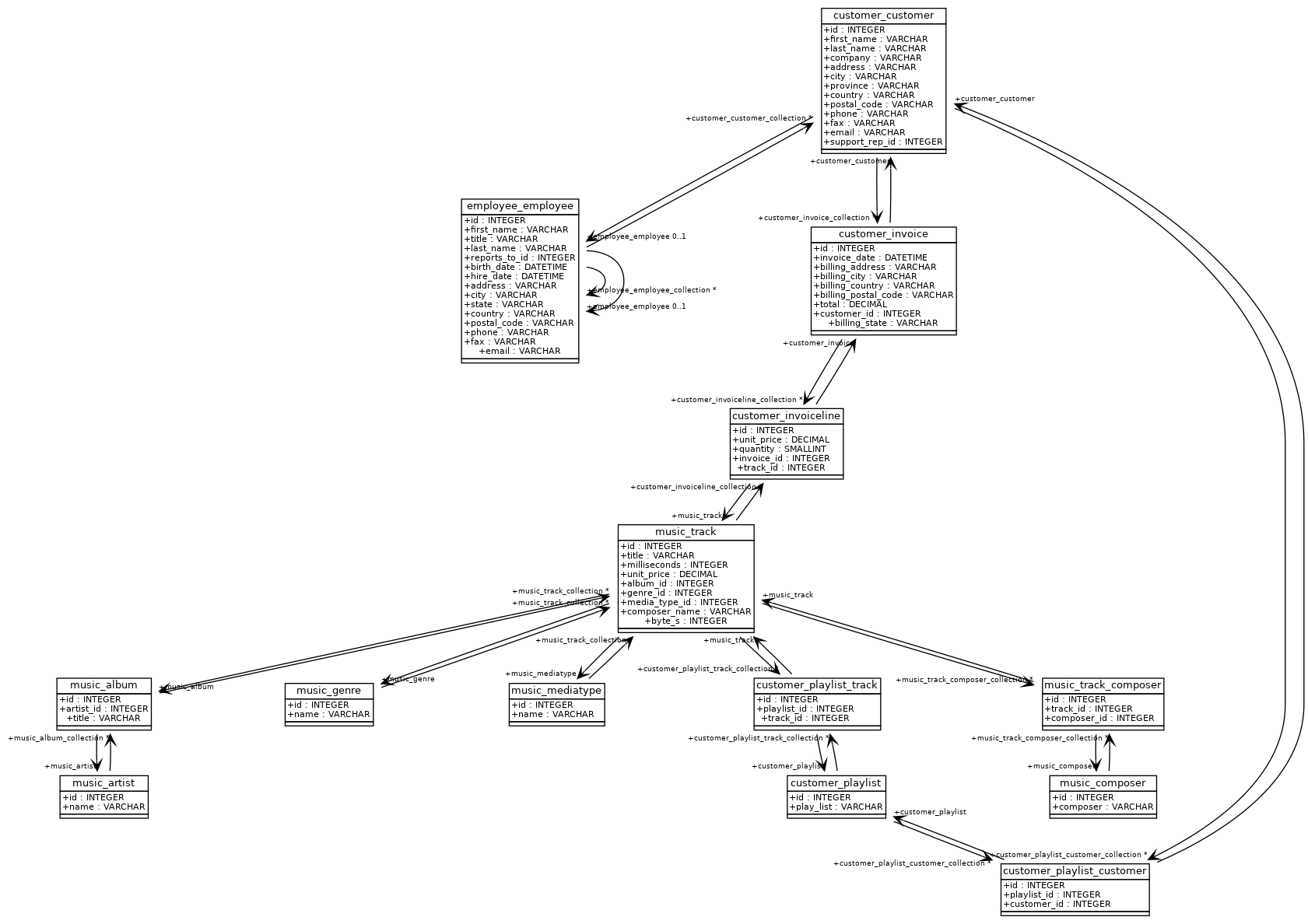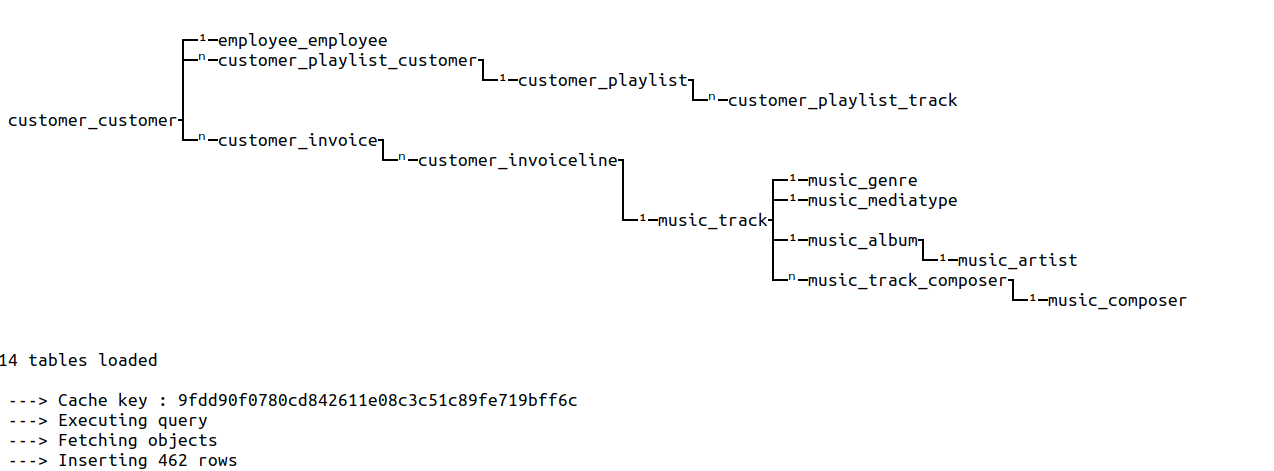
DBcut aims to allow the extraction of lightweight subset of relational production database for development and testing purpose.
Its main features are:
- Extract data from large databases.
- Reinject data into another base.
- Target and source databases could be based on different DBMS (i.e., MySQL -> PostgreSQL/SQLite).
- Extraction queries simplified in YAML.
- Support nested associations.
- Json and plain SQL export.
- Reasonable performance.
- Caching of extractions to accelerate future extractions.
Usage: dbcut [OPTIONS] COMMAND1 [ARGS]... [COMMAND2 [ARGS]...]...
Extract a lightweight subset of your production DB for development and
testing purpose.
Options:
-c, --config PATH Configuration file
--version Show the version and exit.
-y, --force-yes Never prompts for user intervention
-i, --interactive Prompts for user intervention.
--quiet, --no-quiet Suppresses most warning and diagnostic messages.
--debug Enables debug mode.
--verbose Enables verbose output.
-h, --help Show this message and exit.
Commands:
load Extract and load data to the target database.
flush Remove ALL TABLES from the target database and recreate them
inspect Check databases content.
dumpsql Dump all SQL insert queries.
dumpjson Export data to json.
clear Remove all data (only) from the target database
purgecache Remove all cached queries.Let's take the following database example:
We want to extract some users with all related data to our development database.
First, we have to edit the extraction file dbcut.yaml as follows:
# dbcut.yml
databases:
source_uri: mysql://foo:bar@db-host/prod
destination_uri: sqlite:///small-dev-database.db
queries:
- from: user
limit: 2Then, we set the limit to two users, the default limit being 10.
After that, we launch the extraction command with the load command:
$ dbcut load
---> Reflecting database schema from mysql://foo:***@db-host/prod
---> Creating new sqlite:///small-dev-database.db database
---> Creating all tables and relations on sqlite:///small-dev-database.db
Query 1/1 :
from: user
limit: 2
backref_limit: 10
backref_depth: 5
join_depth: 5
exclude: []
include: []
┌─ⁿ─comment
├─ⁿ─vote
user┤
└─ⁿ─user_group┐
└─¹─group┐
└─¹─role┐
└─ⁿ─role_permission┐
└─¹─permission
8 tables loaded
---> Cache key : 4a468c3555074890b7c342c0a575f29d47145821
---> Executing query
---> Fetching objects
---> Inserting 31 rowsWe can check the data on our new database :
$ ls
dbcut.yml small-dev-database.db
$ sqlite3 small-dev-database.dbsqlite> SELECT id, login FROM user;
3|jerome
4|juliensqlite> SELECT * from comment;
8|comment jerome 1|3
9|comment jerome 2|3
10|comment jerome 3|3In the following example, we are going to retrieve roles with related groups and permissions. In order to obtain the
best extraction graph, we are going to use the keyword include, which indicated to dbcut that we want to minimize
the number of associated tables (Nested associations).
queries:
- from: user
limit: 2
- from: role
include:
- group
- permissionIt is possible to empty the content of the local database before beginning the extraction with the clear command.
$ dbcut -y clear load
---> Removing all data from sqlite:///small-dev-database.db database
---> Reflecting database schema from mysql://foo:***@db-host/prod?charset=utf8
---> Creating all tables and relations on sqlite:///small-dev-database.db
Query 1/2 :
from: user
limit: 2
backref_limit: 10
backref_depth: 5
join_depth: 5
exclude: []
include: []
┌─ⁿ─comment
├─ⁿ─vote
user┤
└─ⁿ─user_group┐
└─¹─group┐
└─¹─role┐
└─ⁿ─role_permission┐
└─¹─permission
8 tables loaded
---> Cache key : 4a468c3555074890b7c342c0a575f29d47145821
---> Using cache (2 elements)
---> Fetching objects
---> Inserting 31 rows
Query 2/2 :
from: role
limit: 10
backref_limit: 10
backref_depth: null
join_depth: null
exclude: []
include:
- group
- permission
┌─ⁿ─group
role┤
└─ⁿ─role_permission┐
└─¹─permission
4 tables loaded
---> Cache key : 5029d84dbb2bc75a7df898dd94df93b395e91e44
---> Executing query
---> Fetching objects
---> Inserting 22 rowsAs you can see in the first query, the cache was used and there was thus no interaction with the source database.
This query allowed the extraction of all roles:
sqlite> SELECT * from role;
1|admin
2|moderator
3|userIf we had not used the include keyword, all tables would have been extracted:
┌─ⁿ─role_permission┐
│ └─¹─permission
role┤
└─ⁿ─group┐
└─ⁿ─user_group┐
│ ┌─ⁿ─comment
└─¹─user┤
└─ⁿ─vote
To narrow more precisely our extraction, we are now going to limit to roles that can delete a user.
queries:
- from: user
limit: 2
- from: role
include:
- group
- permission
where:
permission.codename: 'delete_user'Only the last extraction rule is relaunched with the --last-only option.
$ dbcut -y clear load --last-only
...
---> Cache key : ffb664a2e69c88fa48db2680daf71d30408bd207
---> Executing query
---> Fetching objects
---> Inserting 14 rowsThis time, only the 'admin' role is retrieved:
sqlite> SELECT * from role;
1|adminPlease note that the filter only applies here to role table (from) and not to the permission.
sqlite> SELECT * FROM permission";
1|delete_comment
2|delete_vote
3|delete_user
4|create_comment
5|create_vote
6|create_userIndeed, we filter the roles based on a value from the permission table, but we do retrieved all permissions associated to this role.
In the above example, it makes sense that the admin role has all permissions.
Last but not least, we can also retrieve data in json or raw sql format !
$ dbcut dumpjson|dumpsql[
{
"password": "julien",
"vote_collection": [
{
"user_id": 4,
"comment_id": 1,
"id": 3,
"rating": 4
},
{
"user_id": 4,
"comment_id": 3,
"id": 6,
"rating": 10
},
{
"user_id": 4,
"comment_id": 6,
"id": 13,
"rating": 10
}
],
"comment_collection": [],
"id": 4,
"login": "julien",
"user_group_collection": [
{
"user_id": 4,
"group": {
"name": "Utilisateur",
"role": {
"id": 3,
"role_permission_collection": [
{
"permission": {
"id": 4,
"codename": "create_comment",
"role_permission_collection": []
},PRAGMA foreign_keys = OFF;
BEGIN;
INSERT OR IGNORE INTO permission (id, codename) VALUES (4, 'create_comment');
INSERT OR IGNORE INTO permission (id, codename) VALUES (5, 'create_vote');
INSERT OR IGNORE INTO permission (id, codename) VALUES (1, 'delete_comment');
INSERT OR IGNORE INTO permission (id, codename) VALUES (2, 'delete_vote');
INSERT OR IGNORE INTO role (id, name) VALUES (3, 'user');
INSERT OR IGNORE INTO role (id, name) VALUES (2, 'moderator');
INSERT OR IGNORE INTO user (id, login, password) VALUES (4, 'julien', 'julien');
INSERT OR IGNORE INTO user (id, login, password) VALUES (3, 'jerome', 'jerome');
INSERT OR IGNORE INTO "group" (id, name, role_id) VALUES (3, 'Utilisateur', 3);
INSERT OR IGNORE INTO "group" (id, name, role_id) VALUES (2, 'Moderateur', 2);
INSERT OR IGNORE INTO comment (id, content, user_id) VALUES (8, 'comment jerome 1', 3);
INSERT OR IGNORE INTO comment (id, content, user_id) VALUES (9, 'comment jerome 2', 3);
INSERT OR IGNORE INTO comment (id, content, user_id) VALUES (10, 'comment jerome 3', 3);
INSERT OR IGNORE INTO role_permission (id, role_id, permission_id) VALUES (12, 3, 4);
INSERT OR IGNORE INTO role_permission (id, role_id, permission_id) VALUES (13, 3, 5);
INSERT OR IGNORE INTO role_permission (id, role_id, permission_id) VALUES (7, 2, 4);
INSERT OR IGNORE INTO role_permission (id, role_id, permission_id) VALUES (8, 2, 5);
INSERT OR IGNORE INTO role_permission (id, role_id, permission_id) VALUES (10, 2, 1);
INSERT OR IGNORE INTO role_permission (id, role_id, permission_id) VALUES (11, 2, 2);
INSERT OR IGNORE INTO user_group (id, user_id, group_id) VALUES (4, 4, 3);
INSERT OR IGNORE INTO user_group (id, user_id, group_id) VALUES (3, 3, 2);
INSERT OR IGNORE INTO vote (id, rating, user_id, comment_id) VALUES (3, 4, 4, 1);
INSERT OR IGNORE INTO vote (id, rating, user_id, comment_id) VALUES (6, 10, 4, 3);
INSERT OR IGNORE INTO vote (id, rating, user_id, comment_id) VALUES (13, 10, 4, 6);
INSERT OR IGNORE INTO vote (id, rating, user_id, comment_id) VALUES (2, 5, 3, 1);
INSERT OR IGNORE INTO vote (id, rating, user_id, comment_id) VALUES (5, 1, 3, 2);
INSERT OR IGNORE INTO vote (id, rating, user_id, comment_id) VALUES (7, 10, 3, 3);
INSERT OR IGNORE INTO vote (id, rating, user_id, comment_id) VALUES (10, 6, 3, 1);
INSERT OR IGNORE INTO vote (id, rating, user_id, comment_id) VALUES (11, 5, 3, 5);
INSERT OR IGNORE INTO vote (id, rating, user_id, comment_id) VALUES (12, 6, 3, 6);
INSERT OR IGNORE INTO vote (id, rating, user_id, comment_id) VALUES (19, 10, 3, 10);
COMMIT;DBcut heavily uses SQLAlchemy, the SQL toolkit and Object Relational Mapper for Python. The ORM makes it possible to free ourselves from the SQL direct manipulation, but that is not all. SQLAlchemy offers a range of toolkits that enable us to programmatically build all SQL queries useful to DBcut. This include both the schema creation and all of its properties, the select, join and insert queries… no matter which DBMS is used (PostgreSQL, MySQL, SQLite, oracle etc.).
One of the most important features of DBcut is that the user does not need to know or provide the source database schema to use it. First of all, DBcut will inspect the source database and retrieve all metadata. This action is what we call: Database Reflection.
The MetaData object store all the collection of metadata entities. DBcut will alter this MetaData object to make it
compatible with most DBMS. For example, the names of indexes or foreign keys can be too long for SQLite but not for
MYSQL. Sometimes, it also changes the types of the column to make it match what is expected in the target database.
(mysql.TINYINT became SMALLINT in SQLite and PostgreSQL)
Once the MetaData object is complete, we can create the new database which is almost identical to the source database (except some compatibility adjustments)
DBcut will generate and launch extraction request on the source database. The data thus obtained will be detached from
the first SQLAlchemy session to be attached to the new session in the target database. This is where the SQLAlchemy
magic happens: the same request will be used to extract data from the source database and to load them into the target
database. Indeed, in the first case (query/fetch), it will be translated into SQL SELECT queries and in the second
case, into SQL INSERT statements (load).
One of the goals of DBcut is to allow quick writing of extraction requests. Most of the time, to write an extraction request, not much information is needed: only the main table name, hoping to retrieve the maximum number of related data as possible.
The idea was to find a sufficiently concise syntax that allows us to build the most complete extraction requests with the minimum effort.
The YAML came to us naturally as it is pleasant to read, easy to understand and to edit for humans.
The dbcut.yml file is both used to configure DBcut and to write
extraction requests.
databases:
source_uri: mysql://chinook:chinook@192.168.66.66/chinook
destination_uri: sqlite:///chinook.db
queries:
- from: customer_customerTo write an extraction request, only the keyword from is mandatory. However, other keywords can be added to reduce
the size of data to retreive.
- from: contracts_customer
where:
brand: 2
limit: 100
backref_limit: 500
backref_depth: 2
join_depth: 5
exclude:
- django_admin_log
- django_session
include: []Unlike the SQL queries, an extraction request using DBcut automatically and recursively loads all associated relations (See Extraction Graph). All these options are filtering and reducing options that prevents from slowing down the extraction process.
Finally, with the scope of making the extraction requests as compact as possible, we can add default values to most of these options:
default_limit: 100
default_backref_limit: 500
default_backref_depth: 2
default_join_depth: 5
global_exclude:
- django_admin_log
- django_sessionTo build an extraction request, we first build its extraction graph.
An extraction graph is a subset of the complete graph of database relations. Every node represents a table, and each link represents a relation between two tables. The link direction is defined by the foreign key.
To build this graph, we use the MetaData object (See Database Reflection and Loading Stategy).
Let's use the following database schema:
The retrieved metadata during the database reflection are used to build the following complete graph of relations:
To build the extraction graph, we browse the complete graph starting
from the table used in the from instruction. The browsing only stops
if :
- the link has already been browsed
- the table is explicitly excluded
- the maximum depth is reached
For the following request:
queries:
- from: customer_customerThe generated extraction graph is:
Please note that we handle the two types of relations : one-to-many relations (noted 1 in the extraction graph) and
many-to-many relations (noted n).





